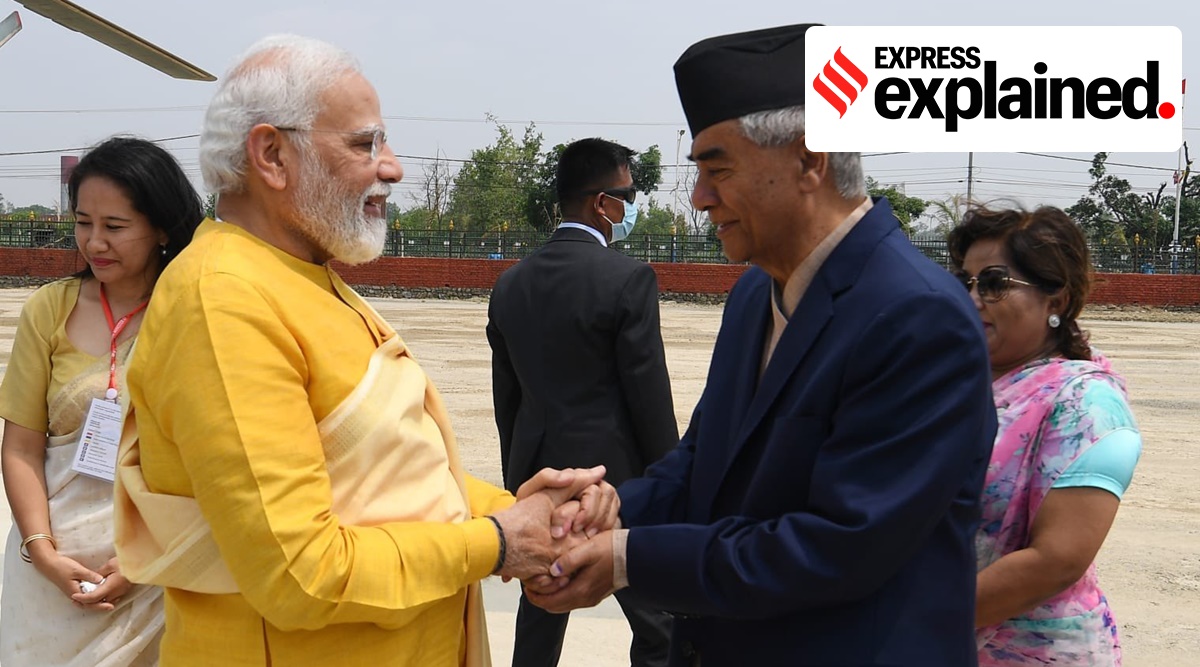 Nepal PM Sher Bahadur Deuba greets Prime Minister Narendra Modi in Lumbini on Monday. (Photo: Twitter/@narendramodi)
Nepal PM Sher Bahadur Deuba greets Prime Minister Narendra Modi in Lumbini on Monday. (Photo: Twitter/@narendramodi)On November 8, 2011, the veteran Congress leader Karan Singh, who was then a member of Rajya Sabha, told an unscheduled press conference during a visit to Nepal: “India would be interested in developing Lumbini in a manner befitting its status on the world map.”
Singh’s statement followed the aggressive pursuit by China of a $3 billion project through one of its NGOs — Asia Pacific Exchange of Cooperation Foundation (APECF) — to develop the birthplace of Lord Buddha into an international “city of peace”.
At a dinner hosted by a Nepali businessman where Nepal’s former King Gyanendra — who was chairman of the Lumbini Development Trust when it was established in 1985 with the aim of restoring the Lumbini Garden — it was underlined that Lumbini was “less than 10 km” from the Indian border.
The Congress was then in power, and Singh was apparently told to convey to Nepal that India had both a cultural and a security interest in the development of Lumbini.
Best of Express Premium
Modi in Lumbini: A new push
More than a decade later, Prime Minister Narendra Modi is in Lumbini on Monday (May 16), the 2,566th birth anniversary of the Buddha, to lay the foundation of a monastery and to address a celebration at the Maya Devi temple. India will join more than a dozen countries including China, Thailand, Vietnam, Myanmar, Japan, Taiwan, and South Korea to have a monastery of its own in the global project.
As he spends several hours in Nepal on Monday, Modi will become the first Indian Prime Minister to visit Lumbini. He had expressed a desire to visit Lumbini during his first official visit to Nepal as Prime Minister in July 2014 — he had, in an address to the Constituent Assembly of Nepal on that occasion, acknowledged the birth of the Buddha in that country, reassuring Nepali sentiment that India would not try to appropriate it.
#WATCH PM Narendra Modi received by Nepal PM Sher Bahadur Deuba on his arrival at Lumbini
PM will visit Mahamayadevi Temple on #BuddhaPurnima today
(Video source: DD) pic.twitter.com/4TSOCIBu8T
— ANI (@ANI) May 16, 2022
The Chinese: First off the block
After the Chinese had declared their plans for Lumbini and roped in Maoist leader and then former Prime Minister of Nepal Pushpa Kamal Dahal ‘Prachanda’ as the APECF’s vice-chairman and project in-charge, the foundation signed an understanding with the United Nations Industrial Development Organisation (UNIDO) to expedite the Chinese vision on Lumbini.
Given the lack of clarity on the project, and Indian and US unease about it, subsequent governments in Nepal did not pursue the initiative further. However, the Chinese continued to focus on Lumbini as part of their project for Nepal.
In 2018, it announced plans to connect Tibet with Kathmandu by a trans-Himalayan railway, and then to Lumbini. Chinese government delegates and political figures often made the 30-minute flight to Lumbini from Kathmandu to send the signal that it was sincere about the development project, and to underline the two countries’ shared Buddhist heritage. It was also the Chinese counter to the claims made by India and other countries that China’s interest in Nepal was rooted purely in business.
Ramayana and Buddhist circuits
And yet, India itself showed no significant interest in building connectivity to Lumbini — or in promoting other shrines in Nepal. As Prime Minister, Modi made a break in this policy disinterest by allocating funds for the renovation of the passage around the Pashupati Nath Temple and the building of a dharmashala for pilgrims.
Both he and Uttar Pradesh Chief Minister Yogi Adityanath visited Janakpur, the birthplace of Sita — and announced a connectivity package to link the pilgrimage centre to Ayodhya by a regular bus service. This was intended to be part of the proposed Ramayan circuit, but the project continues to lack clarity and a concrete roadmap.
By contrast, the Government of India seems more keen to develop the Buddhist circuit, in which Lumbini would be a prominent stop.
Nepal’s Prime Minister Sher Bahadur Deuba will inaugurate the Gautam Buddha International Airport — an expanded and upgraded domestic airport — at Bhairahawa, 18 km from Lumbini, on Monday. Modi will, however, avoid this airport, which has been built with Chinese assistance — the Prime Minister will fly from Kushinagar, another Buddhist pilgrimage and part of the proposed circuit, and his helicopter will land on a new helipad that has been built in Lumbini.
While the Indian message is clearly of shared cultural and religious links with Nepal that are removed from that of any other country, the fact, as an Indian diplomat pointed out privately, is that governments prior to Modi’s had done little to promote India’s soft power and religion in Nepal, and Modi himself had initially focused on the ‘Hindu’ aspect of the relationship — until New Delhi was nudged awake by the Chinese initiative.
- The Indian Express website has been rated GREEN for its credibility and trustworthiness by Newsguard, a global service that rates news sources for their journalistic standards.

